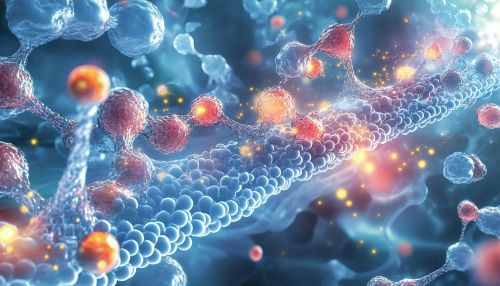Creatine synthesis
Overview of Creatine Synthesis
Creatine synthesis is a biochemical process that occurs primarily in the liver and kidneys, involving the production of creatine, a compound crucial for energy storage and supply in muscle and brain tissues. Creatine plays a significant role in the ATP-phosphocreatine system, which is vital for rapid energy release during high-intensity activities. This process is essential for maintaining cellular energy homeostasis and is intricately linked to various metabolic pathways.
Biochemical Pathway of Creatine Synthesis
The synthesis of creatine involves a two-step enzymatic process. The first step occurs in the kidneys, where the enzyme arginine:glycine amidinotransferase (AGAT) catalyzes the reaction between Arginine and Glycine, resulting in the formation of guanidinoacetate and ornithine. This step is crucial as guanidinoacetate serves as a direct precursor to creatine.
The second step takes place predominantly in the liver, where guanidinoacetate is methylated by the enzyme guanidinoacetate N-methyltransferase (GAMT) using S-adenosyl methionine (SAM) as a methyl donor, producing creatine and S-adenosylhomocysteine. This methylation step is vital for the conversion of guanidinoacetate to creatine, which is then transported via the bloodstream to target tissues such as muscle and brain.


Regulation of Creatine Synthesis
The regulation of creatine synthesis is a complex process influenced by various factors, including dietary intake, hormonal control, and the availability of substrates and cofactors. Dietary intake of creatine, primarily from meat and fish, can significantly impact endogenous synthesis. When dietary intake is sufficient, the body's need to synthesize creatine decreases, demonstrating a feedback inhibition mechanism.
Hormonal regulation also plays a critical role, with growth hormone and insulin-like growth factor 1 (IGF-1) known to upregulate AGAT expression, thereby enhancing creatine synthesis. Conversely, glucocorticoids have been shown to downregulate AGAT, reducing creatine production.
The availability of substrates such as arginine, glycine, and methionine, as well as cofactors like SAM, is essential for optimal creatine synthesis. Deficiencies in these substrates or cofactors can lead to impaired creatine production, affecting muscle and brain function.
Physiological Importance of Creatine
Creatine is stored primarily in skeletal muscle, where it exists in free form or as phosphocreatine. Phosphocreatine serves as a rapid energy buffer, donating its phosphate group to ADP to regenerate ATP during short bursts of high-intensity exercise. This process is crucial for activities requiring quick energy release, such as sprinting or weightlifting.
In addition to its role in energy metabolism, creatine has been implicated in various cellular processes, including Protein Synthesis, cell signaling, and osmoregulation. It also exhibits neuroprotective properties, with studies suggesting its potential in mitigating neurodegenerative diseases.
Clinical Implications of Creatine Synthesis Dysregulation
Dysregulation of creatine synthesis can lead to several clinical conditions. Creatine deficiency syndromes, such as AGAT deficiency, GAMT deficiency, and creatine transporter deficiency, result from genetic mutations affecting the enzymes or transporters involved in creatine metabolism. These disorders are characterized by developmental delays, intellectual disabilities, and seizures, highlighting the importance of creatine in brain function.
Diagnosis of creatine deficiency syndromes involves measuring creatine and guanidinoacetate levels in urine and plasma, along with genetic testing. Treatment strategies include dietary supplementation with creatine or its precursors, which can alleviate some symptoms, although the efficacy varies depending on the specific disorder.
Research and Future Directions
Ongoing research in creatine synthesis aims to elucidate the detailed mechanisms regulating this process and its broader implications in health and disease. Recent studies focus on the role of creatine in aging, muscle wasting conditions, and its potential therapeutic applications in neurodegenerative diseases such as Parkinson's Disease and Alzheimer's Disease.
Advancements in genetic and metabolic engineering hold promise for developing novel therapeutic strategies targeting creatine synthesis pathways. Understanding the interplay between creatine metabolism and other metabolic networks could pave the way for innovative treatments for metabolic and neurological disorders.
